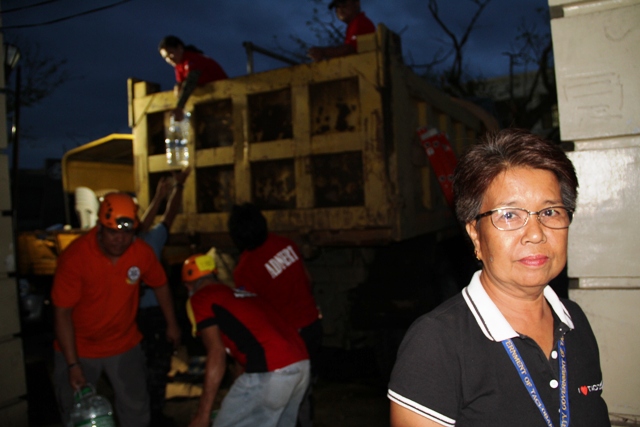Many local aid workers were also victims of the storm, locally known as Yolanda, which left over 5,000 people dead and more than 1,500 missing. More than 14 million people have been affected and over 3.5 million are displaced.
IRIN met with Marilou Nacilla, a 56-year-old social welfare officer and mother of four boys, who is one of thousands of local aid workers in the typhoon-affected area. She was assisting in the evacuation of thousands of residents ahead of the category 5 storm’s arrival and is still on the job, doing what she does best: helping people.
“On the eve of the typhoon, I went to our offices at the Tacloban Social Welfare Development Office on Magsaysay Avenue. There were 10 of us at the building at that time, with several others assigned to evacuation centres throughout the city.
"I decided to sleep at the office to avoid being caught in the storm, which they said would strike in the early morning.
"City authorities had announced a pre-emptive evacuation of thousands of residents who might be in harm's way, especially those living along the coastline, and we (social workers) were assigned to do the task. We worked 24 hours a day, with two shifts working either a day or night shift. I was assigned a day shift.
"When the typhoon struck, the wind and rain was so strong the entire building shook. Almost all the glass in the building’s windows shattered, while the roof began to disintegrate. It was terrifying! A group of us hid in the ladies’ room on the ground flood before the storm surge forced us to again flee – this time to the second floor. At one point I thought we were all going to die.
“When it was over, I was shocked. We could barely recognize our surroundings. One hour later the sea began to recede from the building and we began seeing several dead bodies floating on the water. It was then that survivors began coming in.
“Although I had no idea what happened to my family, and with no communications I knew I had put that aside and immediately begin helping those around me. It was only later when my husband walked through the door that I learned everyone in my family had survived.
“Still wearing the clothes I had hours earlier swum for my life in, I didn’t return home, as I wanted to help as many people as I could.
"Later I learned that a colleague of mine in her early 20s, assigned to one of the evacuation centres, was still missing.
“Over the first week, many of the people coming in had bad scrapes and cuts on them. Others still came in just looking for food and water for their families. We gave them what we could, as supplies slowly began coming in.
"I didn’t go home right away because we were all trying to help the people who had been displaced. As our offices were destroyed, we set up our temporary office at a building adjacent to the city hall. During the first three days there were just five of us working, including our head, chief social worker Liliosa Baltazar.
"During this time, some of my co-workers returned to their own homes to check on their families, but I stayed behind.
"It was only after two weeks, when I was tasked to deliver milk to residents in a village outside town, that I finally got the chance to see my family. I begged the truck driver to give me at least a few minutes.
"The moment my family saw me, they burst out crying, but I tried to control my emotions as I knew I had to remain strong for them. Our house had been completely destroyed.
“'Why cry over spilled milk. Will our house return if we cry?” I asked them. "Never mind the house as long we are all alive,” I said; a sentiment I continue to live with, and that keeps me going today.
“We’ve been given a second chance at life, and that’s why now we have to serve. We (social workers) are like soldiers. It’s our job to help people, even if our families have to come second.”
ds/ds/he
This article was produced by IRIN News while it was part of the United Nations Office for the Coordination of Humanitarian Affairs. Please send queries on copyright or liability to the UN. For more information: https://shop.un.org/rights-permissions




